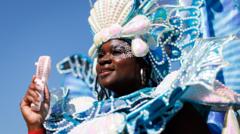How Did Notting Hill Carnival Revellers Celebrate in the Sunny Streets?

Published: 2025-08-25 15:49:08 | Category: technology
The Notting Hill Carnival, Europe's largest street party celebrating Caribbean culture, has taken over west London once again, with the main parade captivating thousands. This vibrant event, which has been a staple for over 50 years, showcases colourful costumes, music, and dance, bringing together diverse communities in a joyous celebration.
Last updated: 30 October 2023 (BST)
Key Takeaways
- The Notting Hill Carnival celebrates Caribbean culture and has been running for over 50 years.
- Thousands attended the event, showcasing performances from various cultural groups.
- A moment of silence was observed for victims of the Grenfell Tower fire.
- Efforts are ongoing to secure funding for the carnival's future.
- Significant logistical efforts were made for clean-up post-event.
The Carnival's Rich Heritage
The Notting Hill Carnival first took place in 1966, born out of the need for an event that recognised and celebrated Caribbean culture in the UK. The carnival was established in response to racial tensions and as a means to foster unity and community spirit. Over the decades, it has evolved into a global cultural phenomenon, attracting participants and spectators from around the world.
What to Expect During the Carnival
As the festivities kick off, the carnival is punctuated by vibrant parades featuring elaborate costumes, traditional music, and dance. From the early morning until late evening, various groups perform along the parade route, each showcasing the unique heritage of their respective cultures.
Performers and Cultural Representation
This year's carnival saw performances from groups like Bajan Raw Licquer, Mahogany, and Vincy Alliance, reflecting the rich cultural tapestry of Caribbean nations such as Trinidad and Tobago, Barbados, and Jamaica. Additionally, Brazilian groups like Paraiso Samba School added to the carnival's multicultural flavour.
The Atmosphere of Celebration
On Monday, the atmosphere was electric, with temperatures soaring to 26°C (79°F). Carnival-goers lined the streets, many dressed in stunning costumes adorned with jewels and feathers. Jeff Sam, a 74-year-old attendee, encapsulated the spirit of the day: "We are here to enjoy ourselves... you're going to see bands from all over the world performing in beautiful costumes."
Craftsmanship on Display
Many costumes are handmade, showcasing the incredible talent and dedication of local artisans. Lauren, a performer, shared that her costume included around 500 jewels, crafted with a tiara that took two hours to create. This level of craftsmanship highlights the carnival's focus on artistry and cultural pride.
Community Spirit and Unity
Many attendees expressed their appreciation for the unity the carnival fosters. James Lewis, who travelled from Birmingham, remarked, "It's amazing to see so many cultures coming together." The event serves as a reminder of the strength found in diversity and community.
Moments of Reflection
As part of the celebrations, a poignant moment occurred when all music and sound systems were silenced for 72 seconds to honour victims of the Grenfell Tower fire and others who have died during carnival celebrations. This act of remembrance underscores the carnival's commitment to community and solidarity.
Logistical Efforts and Clean-Up
Following the festivities, the Kensington and Chelsea Council reported clearing an estimated 150 tonnes of rubbish after the first day. With plans to collect around 300 tonnes over the weekend, the council deployed 180 staff and 45 vehicles to ensure the area was restored for normal activities.
The Future of Notting Hill Carnival
Carnival chair Ian Comfort expressed the need for continued funding to maintain the event's safety and vibrancy. He highlighted the importance of government support, stating that without funding, the quality of performances, costumes, and overall safety could decline. Comfort's call to action emphasises the carnival's role in promoting cultural heritage and community unity.
A Celebration for All
The Notting Hill Carnival is not just a celebration of Caribbean culture; it is a festival for everyone. Ian Comfort's message resonates: "If Carnival is a success, it's because everyone embraced it. It doesn't matter who they are, come and enjoy yourself." This inclusivity is what makes the event a cornerstone of London’s cultural calendar.
Conclusion: A Legacy of Joy and Unity
The Notting Hill Carnival continues to thrive, drawing millions to celebrate culture, heritage, and community. As the festivities unfold, it remains a testament to the power of unity in diversity, ensuring that the spirit of the Caribbean lives on in the heart of London. The future of this cherished event relies on collective support and recognition of its historical and cultural significance.
FAQs
What is the Notting Hill Carnival?
The Notting Hill Carnival is an annual event celebrating Caribbean culture, featuring parades, music, and dance. It has been a staple in London for over 50 years.
When does the Notting Hill Carnival take place?
The carnival typically occurs over the August Bank Holiday weekend, specifically on the Sunday and Monday of that weekend.
How can I participate in the Notting Hill Carnival?
Visitors can participate by joining the parade, attending performances, or enjoying the festivities throughout the streets. Volunteers and performers are often needed and welcomed.
Is the Notting Hill Carnival family-friendly?
Yes, the Notting Hill Carnival is designed to be family-friendly, with events and activities suitable for all ages, particularly during the children's day on Sunday.
How does the carnival honour its history?
The carnival includes moments of reflection, such as silence for victims of tragedies, and aims to educate attendees about its origins and significance in promoting unity and community.



